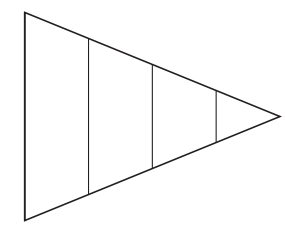Clusters should not be sorted from Major to Supporting and then taught in that order. To do so would strip the coherence of the mathematical ideas and miss the opportunity to enhance the major work of the grade with the supporting clusters.
-
Assessed with:
MAFS.3.NF.1.1
- Test Item #: Sample Item 1
- Question:
A triangle representing one whole is shown.

Complete the sentences to make true statements about the triangle. For each blank, fill in the circle before the word or phrase that is correct.
The parts of the triangle have A. equal areas since they are A. the same size.
B. unequal B. different sizes.
The area of each part is A. one-fourth.
B. unknown.
- Difficulty: N/A
- Type: ETC: Editing Task Choice
Related Courses
Related Access Points
Related Resources
Formative Assessments
Lesson Plans
Presentation/Slideshow
Problem-Solving Tasks
Virtual Manipulatives
STEM Lessons - Model Eliciting Activity
The students will plan a vegetable garden, deciding which kinds of vegetables to plant, how many plants of each kind will fit, and where each plant will be planted in a fixed-area garden design. Then they will revise their design based on new garden dimensions and additional plant options. Students will explore the concept of area to plan their garden and they will practice solving 1 and 2-step real-world problems using the four operations to develop their ideas.
Model Eliciting Activities, MEAs, are open-ended, interdisciplinary problem-solving activities that are meant to reveal students’ thinking about the concepts embedded in realistic situations. Click here to learn more about MEAs and how they can transform your classroom.
MFAS Formative Assessments
Students partition a rectangle into four equal parts and describe each part using a fraction.
Students partition an irregular hexagon into two equal parts and describe each part using a unit fraction.
Students divide figures into two parts, each having the same area, and write the unit fraction representing each part.
Students divide a hexagon into two, three, and six equal parts and write the unit fraction representing each part.
Student Resources
Presentation/Slideshow
This is an accessible, easy-to-read book introducing fractions. It can be downloaded in PowerPoint, Impress, and Flash formats. For struggling or non-readers the book can be read aloud in a variety of voices. All of the books on the Tar Heel Reader site can be used with the Intellikeys keyboard with a custom overlay, a touch screen, and/or 1-3 switches. The text and background colors can be modified for students with visual impairments.
Type: Presentation/Slideshow
Problem-Solving Tasks
This task continues "Which pictures represent half of a circle?" moving into more complex shapes where geometric arguments about cutting or work using simple equivalences of fractions is required to analyze the picture. In order for students to be successful with this task, they need to understand that area is additive.
Type: Problem-Solving Task
This task presents students with some creative geometric ways to represent the fraction one half. The goal is both to appeal to students' visual intuition while also providing a hands on activity to decide whether or not two areas are equal. In order for students to be successful with this task, they need to understand that area is additive.
Type: Problem-Solving Task
Virtual Manipulative
Match shapes and numbers to earn stars in this fractions game.
- Match fractions using numbers and pictures
- make the same fractions using different numbers
- Match fractions in different picture patterns
- Compare fractions using numbers and patterns
Type: Virtual Manipulative
Parent Resources
Presentation/Slideshow
This is an accessible, easy-to-read book introducing fractions. It can be downloaded in PowerPoint, Impress, and Flash formats. For struggling or non-readers the book can be read aloud in a variety of voices. All of the books on the Tar Heel Reader site can be used with the Intellikeys keyboard with a custom overlay, a touch screen, and/or 1-3 switches. The text and background colors can be modified for students with visual impairments.
Type: Presentation/Slideshow
Problem-Solving Tasks
This task continues "Which pictures represent half of a circle?" moving into more complex shapes where geometric arguments about cutting or work using simple equivalences of fractions is required to analyze the picture. In order for students to be successful with this task, they need to understand that area is additive.
Type: Problem-Solving Task
This task presents students with some creative geometric ways to represent the fraction one half. The goal is both to appeal to students' visual intuition while also providing a hands on activity to decide whether or not two areas are equal. In order for students to be successful with this task, they need to understand that area is additive.
Type: Problem-Solving Task
Virtual Manipulative
Match shapes and numbers to earn stars in this fractions game.
- Match fractions using numbers and pictures
- make the same fractions using different numbers
- Match fractions in different picture patterns
- Compare fractions using numbers and patterns
Type: Virtual Manipulative









